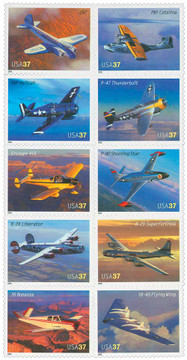
U.S. #3923
37¢ B-29 Superfortress
American Advances in Aviation
Issue Date: July 29, 2005
City: Oshkosh, WI
Printed By: Ashton-Potter (USA) Ltd
Printing Method: Lithographed
Perforations: Serpentine Die Cut 10.75 x 10.5
Quantity: 110,000,000
Color: Multicolored
&... more
U.S. #3923
37¢ B-29 Superfortress
American Advances in Aviation
Issue Date: July 29, 2005
City: Oshkosh, WI
Printed By: Ashton-Potter (USA) Ltd
Printing Method: Lithographed
Perforations: Serpentine Die Cut 10.75 x 10.5
Quantity: 110,000,000
Color: Multicolored
Boeing’s B-29 was called Superfortress with good reason. It had a gross weight of more than 100,000 pounds, was 99-feet long, and had a wingspan just over 141 feet. After the Japanese attacked Pearl Harbor, four huge factories were built to produce B-29s.
The airplane was the most technically advanced bomber of World War II. It had remote-controlled guns and pressurized tail-gunner and crew areas, allowing the plane to fly very fast at high altitudes.
The B-29 flew mainly in the Pacific during World War II. Hundreds of Superfortresses at a time attacked mainland Japan. Its great range, more than 3,200 miles, enabled it to make the long flight from Chinese airstrips to Japan and back.
Finally, on August 6, 1945, a B-29 named Enola Gay dropped an atomic bomb on Hiroshima, Japan. Between 70,000 and 100,000 people were killed in the blast. Three days later, a B-29 named Bockscar, dropped an atomic bomb on Nagasaki, killing 39,000 people instantly. Japan surrendered shortly afterwards.
Post-war, B-29s were used for various peacetime purposes. They saw military action again in the Korean War (1950-53). The last Superfortress in squadron use was retired from service in September 1960.
Less
Most Orders Ship
within 1 Business Day
90 Day Return Policy
Satisfaction Guaranteed
Earn Reward Points
for FREE Stamps & More












